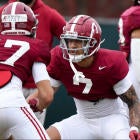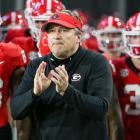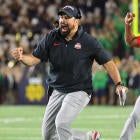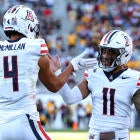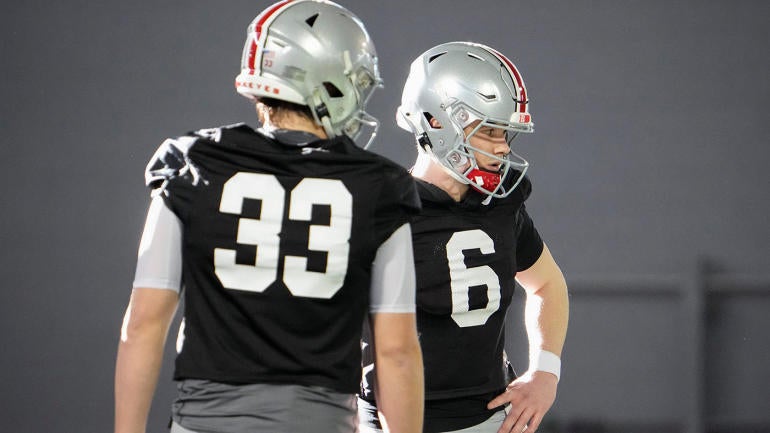
The Big Ten enjoyed a lot of success in the 2022 college football season. Even before the season began, the conference added USC and UCLA to the fold during the summer before securing a landmark media rights deal. When the games were played, the conference ended the year by getting two teams into the four-team College Football Playoff field. While neither Ohio State nor Michigan managed to win their respective playoff semifinal games, Penn State at least salvaged some postseason dignity by winning the Rose Bowl.
So how will the conference perform in 2023? There have been major shakeups within the league, with two big-name coaching hires at Nebraska and Wisconsin, as well as an unanticipated change of leadership at Purdue.
Those aren't the only programs facing questions this spring. Every team around the country has a multitude of questions they need to answer before the season, and even more when the games begin again. These are the biggest questions facing the 14 teams (for now) that comprise the Big Ten as spring practices heat up around the nation.
Illinois
Can the passing attack find more explosive plays? Illinois finished last season 8-5, the most wins it's had in a season since reaching the Rose Bowl in 2007. It did so thanks to one of the best defenses in the country. Illinois allowed only 12.8 points per game (the best mark in the country) and allowed more than 24 points in a game only once. In fact, the Illini only allowed 23 points per game in their five losses.
Unfortunately, the Illini offense managed only 24.2 points per game and was held to 20 points or fewer in five games. The primary reason was a lack of big plays in the passing game. While Illinois finished a respectable 63rd nationally in explosive play rate on the ground, its 12.7% explosion rate in the passing game ranked 99th. It's hard to score points consistently in this day and age without big plays. The Illini are hoping that Ole Miss transfer QB Luke Altmyer can help and receivers like Isaiah Williams can take a step forward in that department this year.
Indiana
Can the defense create more havoc? Indiana surprised the college football world in 2020 when it went 6-2 and picked up wins over Penn State, Michigan and Wisconsin while hanging with Ohio State. Since then, the Hoosiers are 6-18 overall and 2-16 in the Big Ten. There's no specific reason why this has happened, but for a program like Indiana to win, it has to do so at the margins. In 2020, the Hoosiers forced 20 turnovers in eight games (most in the Big Ten) and led the conference in havoc rate. After forcing 20 turnovers in 2020, the Hoosiers have forced only 22 in the last two seasons combined. That ranks 128th nationally. The team's havoc rate of 12.7% ranks 117th.
Expecting Indiana to compete for a division title is foolish, but if the program wants to get back to a bowl game and compete within the conference, causing more problems defensively would be a great place to start. Unfortunately, the team's most disruptive presence on defense last season, Dasan McCullough, transferred to Oklahoma. Somebody else will have to step up, and the coaching staff has to figure out how to maximize its available talent.
Iowa
Will the new-look offense be any different? We've all made our jokes about Brian Ferentz needing to average 25 points per game this season, but I want to know if Iowa plans to change anything on offense or if it's simply hoping that more talented players will fix everything. Michigan transfer quarterback Cade McNamara isn't going to win a Heisman, but he's a clear upgrade on Spencer Petras and Alex Padilla. The Hawkeyes also added TE Erick All (Michigan) and offensive linemen Rusty Feth (Miami, OH) and Daijon Parker (Saginaw Valley).
Both of Iowa's leading receivers last year were tight ends, so while All is a nice addition, I don't know that he fixes a problem as much as he replaces Sam LaPorta. What I'd like to see, if I'm an Iowa fan, is for somebody -- anybody -- in the wide receiver room to step up and for the offense to add a few more modern wrinkles. Nobody is saying Iowa needs to start running the Air Raid, but at some point, it can't just be the WR talent or QB who is the problem.
Maryland
Can Taulia Tagovailoa take another step forward? When your QB gets sacked a lot, it doesn't necessarily mean you have a bad offensive line. Sometimes it's the QB who needs to take the blame. For instance, Maryland's offensive line ranked 28th nationally in pressure rate allowed last season (28%). That's well above average. However, Maryland's sack rate allowed of 6.9% ranked 78th. Typically, when you see a disparity that wide, that tells you the QB is holding on to the ball too long.
In a conference with a lot of question marks at the QB position, Maryland is in a good spot with Tagovailoa, but it's hard to argue he didn't regress last season. After throwing for 3,860 yards and 26 TDs in 2021, Tagovailoa finished with 3,008 yards and 18 TDs last season. His YPA dropped from 8.1 to 7.7. If Maryland is going to post its first winning Big Ten record since joining the conference (it went 4-4 its first year and has been below .500 every season since), he needs to do a better job of getting the ball out on time.
Michigan
Can Josaiah Stewart jump-start the pass rush? The Wolverines defense remained one of the best in the country last season despite the loss of players like Aidan Hutchinson and David Ojabo, as well as the change from Mike Macdonald to Jesse Minter at defensive coordinator. But after ranking 17th nationally in pressure rate on defense, the Wolverines fell to 48th nationally last year. Mike Morris led the team with 7.5 sacks last season, but he was the only player with more than five, and he's left for the NFL.
Enter Coastal Carolina transfer Josaiah Stewart, who finished last season with 10 tackles for loss with the Chanticleers, though he only tallied three sacks. Michigan was very active in the transfer portal this season, with Stewart being one of the primary additions. Stewart, along with others like rising sophomore Derrick Moore, will be tasked with improving the pass rush; even if Michigan has shown it can win without a dominant pass-rush presence, it cannot be ignored that 14 of the team's 37 sacks came in games against Colorado State and Indiana. Against Penn State, Illinois, Ohio State and TCU, the Wolverines managed only four sacks and 11 tackles for loss.
Michigan State
Will there be improvement on defense? New year, same question in East Lansing, Michigan. The only difference is last season the Spartans were coming off an 11-2 season and Peach Bowl victory. The defense remained a problem in 2022 as the Spartans finished 5-7. The defense finished 94th nationally in points allowed per drive, 88th in yards per play and 97th in expected points added (EPA) per play. They were particularly atrocious against the pass, finishing 122nd in EPA per dropback.
Michigan State has played a bend-but-don't-break style on defense under Mel Tucker, and it broke far too often last year. In 2021, Sparty's defensive red-zone efficiency ranked 19th nationally. Last season, it fell to 72nd. Defensive coordinator Scottie Hazelton needs to find answers to fix what went wrong last year because if the Spartans are left trying to answer the same question next spring, the odds are high it'll be someone else looking for the answer.
Minnesota
How do you replace the "core" of your offense? By my estimate, Tanner Morgan was Minnesota's QB for the last 25 years, but now he's gone. Mo Ibrahim rushed for 11 billion yards on four billion carries in those 25 years, but he's gone, too. The Gophers are also without the interior of their offensive line after their center and both guards have moved on. So how will an offense that's been as run-dominant as any program in the country go about replacing so many key components of that rushing attack?
We got a glimpse at Morgan's replacement, Athan Kaliakmanis, last season, but his performance was inconsistent as he completed only 54.1% of his passes and threw more interceptions than touchdowns. Can he bring more to the passing game this season, or will the Gophers once again rely on grinding opponents into dust? If so, will there be a primary back to replace Ibrahim or are we likely to see a committee?
Nebraska
Can the Huskers protect their QB? Nebraska has had a lot of problems lately, and Matt Rhule will not be able to fix everything in his first season. One area he should try to improve immediately, however, is the ability to protect the QB. Will it be Casey Thompson or Jeff Sims? I don't know, but what's more important is keeping either of them upright and in a clean pocket.
Nebraska allowed pressure on 41.5% of its dropbacks last season. That was the worst mark in the Big Ten by far (Iowa was 13th at 37.8%) and ranked 127th nationally. It is hard to play the QB position at the Power Five level. It is infinitely harder if multiple defenders are in your face while trying to play QB at the Power Five level. If Nebraska can't improve upon that in 2023, it's hard to imagine a lot of improvement overall.
Northwestern
Where have you gone, Clayton Thorson? I used to poke fun at my former Cover 3 Podcast co-host and current Vanderbilt general manager Barton Simmons about his fondness for Northwestern's Clayton Thorson. Barton believed Thorson was a special player, while I viewed him as just a guy, though a guy who proved exceptional at the QB sneak. Perhaps there's a reason Barton is now the GM of a Power Five program and I'm writing this story because have you seen how Northwestern's offense has performed post-Thorson?
In Thorson's final three seasons as starter, the Wildcats went 26-14 and averaged 26.4 points per game. In the last four seasons without Thorson, the Cats are 14-31 while scoring 17.4 points per game. Nationally, this team has ranked 129th in passing efficiency, 114th in completion rate, 127th in EPA per dropback and 129th in explosive pass rate. Yes, Northwestern's defensive performance has dropped off the last couple of seasons and needs to improve. However, no amount of defensive improvement will mean much if the Wildcats don't make serious strides at the QB position.
Ohio State
Who will win the starting QB job? From Northwestern's QB problem to a very different QB problem at Ohio State. Kyle McCord is expected to win the starting job, but it's not a given. He's competing with Devin Brown, who was a highly rated QB himself, ranking No. 6 among all QBs in the 2022 class. Furthermore, Brown wears the No. 33 to honor Sammy Baugh. I don't know if it will impact the competition, but maybe it should?
Anyway, this is a huge opportunity for both. The last three Ohio State QBs have been first-round NFL Draft picks. C.J. Stroud could be the first pick in the draft this spring. Add on the annual expectations of competing for Big Ten titles, CFP berths and ending the two-game losing streak to Michigan, and there's a lot of weight on the shoulders of whomever wins this competition.
Penn State
Is Drew Allar really The Chosen One? Penn State bounced back in a big way last season. After going 11-11 throughout 2020 and 2021, the Nittany Lions went 11-2 in 2022 and beat up everybody they played except Ohio State and Michigan. Of course, if Penn State wants to get to the promised land, it must beat Ohio State and Michigan. Many have felt the one thing James Franklin has lacked in his time with Penn State is a top-tier QB. He's had plenty of guys with moxie who overachieved, but the first-round pedigree guy that has seemed so important to teams not named Georgia hoping to win national titles has been missing.
Enter Drew Allar, a five-star prospect in the 2022 class who ranked as the No. 4 QB overall behind Cade Klubnik (Clemson), Conner Weigman (Texas A&M) and Ty Simpson (Alabama). He saw snaps last year serving as Sean Clifford's backup, but a lot more will be asked of him this season. This spring is the first chance to see him running the offense and will provide the first glimpse of whether or not he can take Penn State to another level.
Purdue
How quickly can Ryan Walters turn around the pass defense? During Ryan Walters' third game as defensive coordinator at Illinois in 2021, he watched his defense allow 42 points as Brennan Armstrong and Virginia torched his secondary repeatedly. The week before, the Illini defense allowed 37 points in a home loss to UTSA. Walters then changed the defensive approach in Champaign, and over the final nine games of the 2021 season and the entirety of 2022, Illinois had one of the best defenses in the country. It was a drastic enough turnaround to help Walters land the Purdue job once Jeff Brohm left for Louisville.
How quickly can he turn the defense around in West Lafayette, Indiana? Purdue won the Big Ten West last season but allowed 27.4 points per game playing in a division where it was considered the lone high-powered offense. The Purdue defense was pretty solid against the run but ranked 82nd nationally in EPA per dropback and 105th in red zone efficiency. The Illini defense finished 6th and 1st in each category, and is expected to see three members of its secondary drafted this spring. If Walters can improve the Purdue defense as quickly as he did the Illinois unit, then with the addition of former Texas starter Hudson Card at QB this Purdue team could be better than the team that won the division last year.
Rutgers
Is Gavin Wimsatt the answer? The QB position has been a significant problem for Rutgers since Greg Schiano began his second stint leading the program. Since the 2020 season, the Knights offense ranks 127th nationally in passing efficiency, 128th in yards per attempt, 128th in EPA per dropback and 131st in explosive pass rate. No matter how you spin it, it's bad. Gavin Wimsatt was one of three Rutgers QBs to start games last season, and while he has a strong arm, Wimsatt has yet been able to harness it in action.
He finished only 44.8% of his passes last season with five touchdowns and seven interceptions. His 5.2 yards per attempt ranked 125th out of 125 qualified passers last season, yet his air yards (yards past the line of scrimmage a pass travels) per attempt of 10.03 ranked 24th. If Rutgers can get Wimsatt to accept the singles and doubles instead of looking exclusively for home runs, it could go a long way toward finally finding consistency at the position.
Wisconsin
What is this all going to look like? Wisconsin is the most fascinating program in the Big Ten this spring. Every team has questions, but we truly have no idea what Wisconsin will look like. It's not just the coaching change from Paul Chryst to Luke Fickell, but also the philosophical change. Wisconsin is a program that rose to relevance in the Big Ten in the last three decades by lining up large running backs behind larger offensive lines and pounding you into submission.
Fickell has brought on Phil Longo as his offensive coordinator, and his spread offense is very different than what Wisconsin has run before. That's not to say it won't be successful. We don't know. We also don't know how long it will take for a program to change its identity so drastically. Not long ago, it was a process that took years (ask Rich Rodriguez how it worked at Michigan), but in the transfer portal era? The process can move a lot quicker now.















